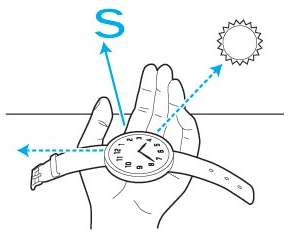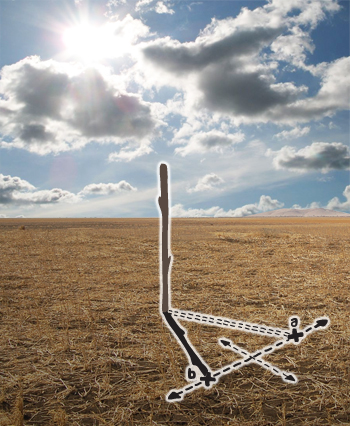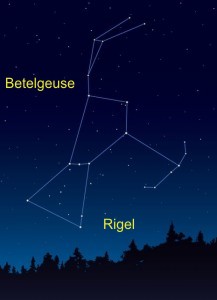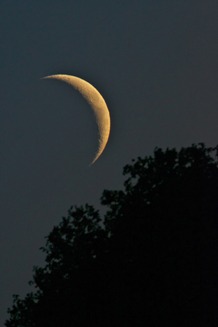When trying to locate something, search your mind first. - Craig Bruce
The Sun
The sun rises in the east and sets in the west, but not exactly, because there is a seasonal variation. In the Northern Hemisphere, when at its highest point in the sky, the sun will be due south; in the Southern Hemisphere this noonday point will mark due north. The hemisphere will be indicated by the way that shadows move; clockwise in the north, anticlockwise in the south.
Shadow Tip Method
Method 1: Find a straight stick about a meter long and locate a level spot with no brush in which a shadow will be cast. Place the stick in the ground and mark the shadow's tip. Wait 10-15 minutes until the shadow tip moves and mark the shadow tip's new position. Then draw a line through the two marks to obtain an approximate east-west line. The first mark will always be west. Stand with the first mark (west) to your left and the second mark to your right. You are now facing north.
Method 2: Another, more accurate, method (if you have the time) is to mark the first shadow tip in the morning. Draw a clean arc at exactly this distance from the stick, using the stick as a centre point. As midday approaches the shadow will shrink and move. In the afternoon, as the shadow lengthens again, mark the EXACT spot where it touches the arc. Join the two points to give east and west. West is the morning mark.
Watch Method
If you have a watch with hands, it can help you find your way. The direction will be accurate if you are using a true local time with no changes for daylight savings time. Also, the further you are from the equator, the more accurate this method will be. If you have a digital watch, all is not lost. Just draw a circle on a piece of paper with the correct time shown. Assuming you are in the northern hemisphere, hold the watch horizontal and point the hour hand at the sun. Bisect the angle between the hour hand and the 12:00 mark to get a north - south line. ( for the Southern Hemisphere point 12 towards the sun. A mid-point between 12 and the hour will give you the North-South line.) If you have trouble deciding which end of the line is north, remember that the sun rises in the east and sets in the west. It is due south at noon, east before noon, and west after noon.
Note: If your watch is set on daylight savings time, use the midway point between the hour hand and the 1:00 mark to determine the north - south line.

The Night Sky
The stars stay in the same relation to one another and pass over the same places on the earth night after night.Their passage over the horizon starts 4 minutes earlier each night a 2 hour difference in time over a month. Rising in the East, stars attain a zenith and set on the western horizon at the same distance from their zenith as they rose.
The Great Bear
To locate Polaris (The North Star), Ursa Major (The Great Bear) is helpful, because it never sets and is always visible on a clear night. The Big Dipper is the central feature of Ursa Major and wheels around Polaris. The two stars Dubhe and Merak point, beyond Dubhe, almost exactly to Polaris about four times farther away than the distance between them. Another useful constellation is Cassiopeia, shaped like a W it also wheels around Polaris. It is on the opposite side of Polaris and about the same apparent distances away as The Big Dipper, the center of the W points towards Polaris. After finding The North Star, imagine a line drawn from the North Star perpendicular to the earth. The point at which the line reaches the horizon is north.
Orion
The Constellation Orion can also be used to locate direction. Orion rises above the Equator and can be seen in both hemispheres. It rises on its side (Back), due East, irrespective of the observer's latitude, and sets due West. Orion appears farther away from the Polaris (The North Star) than the previous constellations. He is easy to spot by the three stars making his belt.
The Crescent Moon
An easy way to achieve a approximate bearing South is to draw a line that connects the horns of a crescent moon. Mentally extend this line down to the horizon. In northern latitudes this will give an rough direction of south. It works best when the moon is high in the sky.






